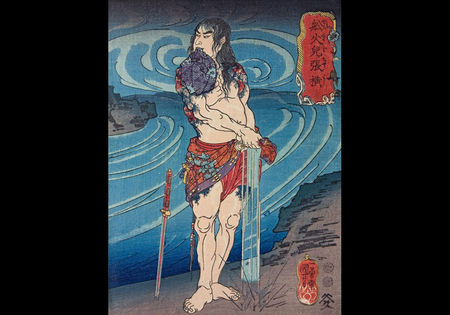Utagawa Kuniyoshi @ the Royal Academy of Arts
Utagawa Kuniyoshi, Mitsukuni Defies the Skeleton-spectre Conjoured up by Princess Takiyasha, 1845 46 Colour woodblock, oban triptych (centre sheet) 37.2 x 25.3 cm. The British Museum, JA 1915.8-23.0915, 09
LONDON.- This Spring, the Royal Academy of Arts will present an exhibition on one of the greatest Japanese print artists, Utagawa Kuniyoshi (1797 – 1861). Featuring over 150 works, the exhibition will present Kuniyoshi as a master of imaginative design. It will reveal the graphic power and beauty of his prints across an unprecedented range of subjects highlighting his ingenuous use of the triptych format. The majority of the exhibition will be drawn from the outstanding collection of Professor Arthur R. Miller which has recently been donated to the American Friends of the British Museum. This is the first major exhibition in the United Kingdom on Utagawa Kuniyoshi since 1961.
Kuniyoshi was a major master of the ‘floating world’, or Ukiyo-e school of Japanese art, and, together with Katsushika Hokusai (1760 – 1849), Utagawa Hiroshige (1797 – 1858) and Utagawa Kunisada (1786 – 1864), dominated nineteenth century printmaking in Japan. Prolific and multitalented, Kuniyoshi considerably expanded the existing repertoire of the school, particularly with thousands of designs that brought vividly to life famous military exploits in Japan and China. He portrayed historic heroes of Japan’s warrior past and brigands from the Chinese adventure story The Water Margin giving dramatic pictorial expression to the great myths and legends that had accrued around them.
Kuniyoshi’s images of heroes, with which he made his name, constitute the most important part of his artistic output. However, censorship regulations frequently required him to displace events of recent centuries to a more distant fictionalised past. Kuniyoshi developed an extraordinarily powerful and imaginative style in his prints, often spreading a scene dynamically across all three sheets of the traditional triptych format and linking the composition with one bold unifying element - a major artistic innovation.
Kuniyoshi was also very active in the other major subjects and genres of floating world art: prints of beautiful women, Kabuki actors, landscapes, comic themes, erotica and commissioned paintings. In each of these he was experimental, imaginative and distinctly different from his contemporaries. For example, he transformed the genre of landscape prints by incorporating Western conventions, such as cast shadows and innovative applications of perspective. This departure from tradition is an indication of his independent artistic spirit.
The exhibition will be divided into six sections beginning with ‘Kuniyoshi’s Imagination’ which presents the range of the artist’s repertoire and his unique treatment. Then there follow more indepth selections: warriors, landscapes, beauties, theatre and humour. Highlights will include rare original brush drawings and a woodblock, a selection of extraordinary dynamic triptych prints and one of the only known examples of a set of twelve comic erotic prints.
The exhibition will include works from the American Friends of the British Museum (The Arthur R. Miller Collection), the British Museum, the Victoria and Albert Museum, the National Museum of Scotland, the Fitzwilliam Museum, Cambridge and private collections in Japan and USA.
Kuniyoshi is the third exhibition in a series dedicated to Japanese Artists and Printmakers to be held at the Royal Academy of Arts. The previous exhibitions have been Hokusai (1991-92) and Hiroshige: Images of Mist, Rain, Moon and Snow (1997).
Utagawa Kuniyoshi, The Chinese warrior Zhang Heng, 1847-48 Colour woodblock, chūban 24.5 x 18.2 cm. American Friends of the British Museum (The Arthur R. Miller Collection) 10221
Utagawa Kuniyoshi, Sakata Kaidō-maru wrestles with a giant carp, c. 1837. Colour woodblock, ōban, 37.8 x 26 cm American Friends of the British Museum (The Arthur R. Miller Collection) 21215

/https%3A%2F%2Fprofilepics.canalblog.com%2Fprofilepics%2F1%2F0%2F100183.jpg)
/https%3A%2F%2Fstorage.canalblog.com%2F03%2F02%2F119589%2F96711876_o.jpg)
/https%3A%2F%2Fstorage.canalblog.com%2F11%2F31%2F119589%2F94773502_o.jpg)
/https%3A%2F%2Fstorage.canalblog.com%2F20%2F83%2F119589%2F94772815_o.jpg)
/https%3A%2F%2Fstorage.canalblog.com%2F26%2F72%2F119589%2F75604929_o.jpg)
/https%3A%2F%2Fstorage.canalblog.com%2F59%2F60%2F119589%2F26458628_o.jpg)





/http%3A%2F%2Fstorage.canalblog.com%2F51%2F86%2F119589%2F127782228_o.jpg)
/http%3A%2F%2Fstorage.canalblog.com%2F87%2F77%2F119589%2F121450336_o.jpg)
/image%2F1371349%2F20240423%2Fob_b2fe42_telechargement-9.jpg)
/image%2F1371349%2F20240423%2Fob_af8bb4_telechargement-6.jpg)